Cascadia – the Bioregion whose watersheds pass through maritime rainforests unique to the Pacific Northwest region of Turtle Island on their way to the Pacific ocean. She ranges from SE Alaska to Northern California to the Rocky Mts centering around the Cascade Mts. She is also an imagination of a new sovereignty, which respects the rights of nature, has aligned itself with indigenous values and a commitment to emergent sustainable culture. Douglas Fir is a tree which connects much of the region and has become a symbol for the ecological experience that unifies the humanity within it’s bounds. Who is the tree? What is it’s ancient history? How is it connected to surrounding bioregions? What kind of stresses and migrations will it experience with accelerating climate change? These are some of the questions explored in this piece.

Ancient Northwest Cascadian forests illuminate majesties unique to the planet. The tallest trees living on earth make their home here. On the southern edge of Cascadia, Sequoia Redwoods include the tallest known living tree on earth. As recently as a century ago the runner up species – Coastal Douglas Fir had specimens taller than the tallest living Sequoia. The tallest living Doug Fir tree is located on the central Oregon Coast – while the oldest – estimated to be over 1300 yrs old is on Vancouver Island in British Columbia – the northern edge of its current native range. Interestingly the primary range of Turtle Island’s Douglas Fir – one of the largest habitats of any tree – stretches a distance 3000 miles long and 1500 miles wide. The heart of this range is Cascadia – the lands whose waters find their ways to the Ocean passing through temperate rainforests at the heart of our coastline and mountains. The tree, together with Salmon, have become central symbols of Cascadia.
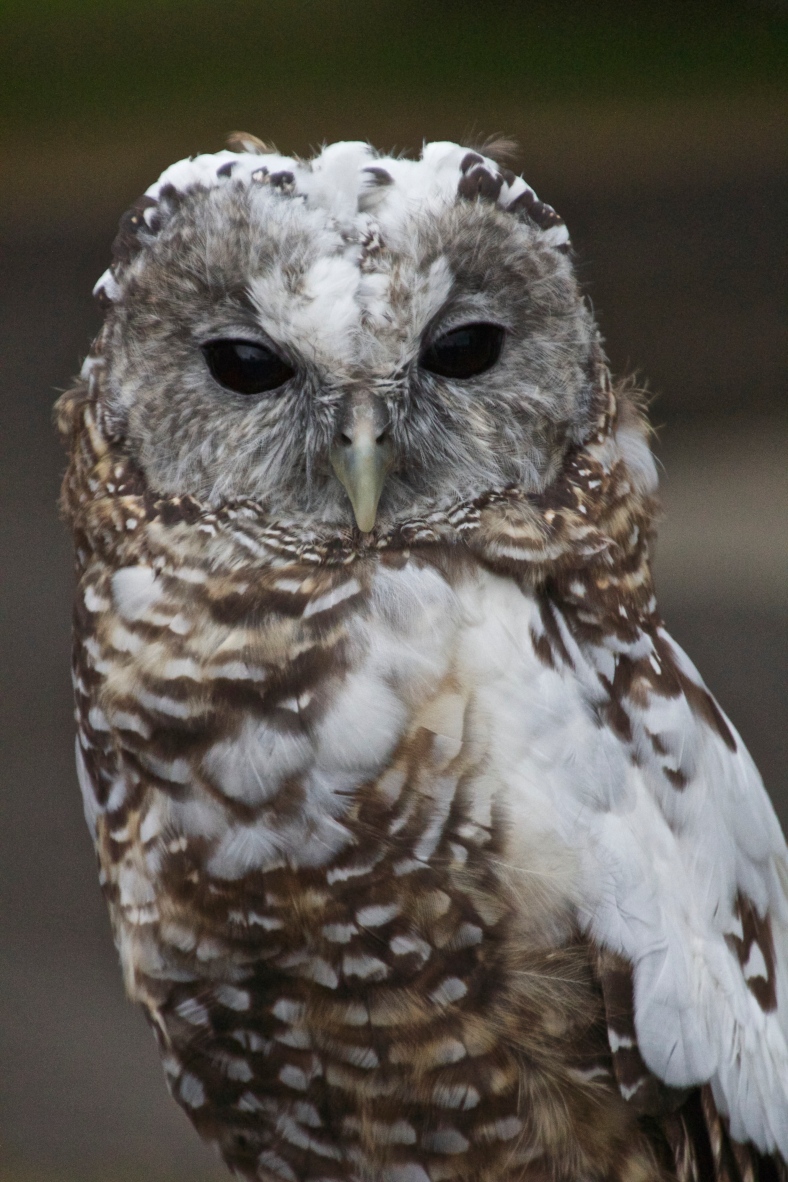
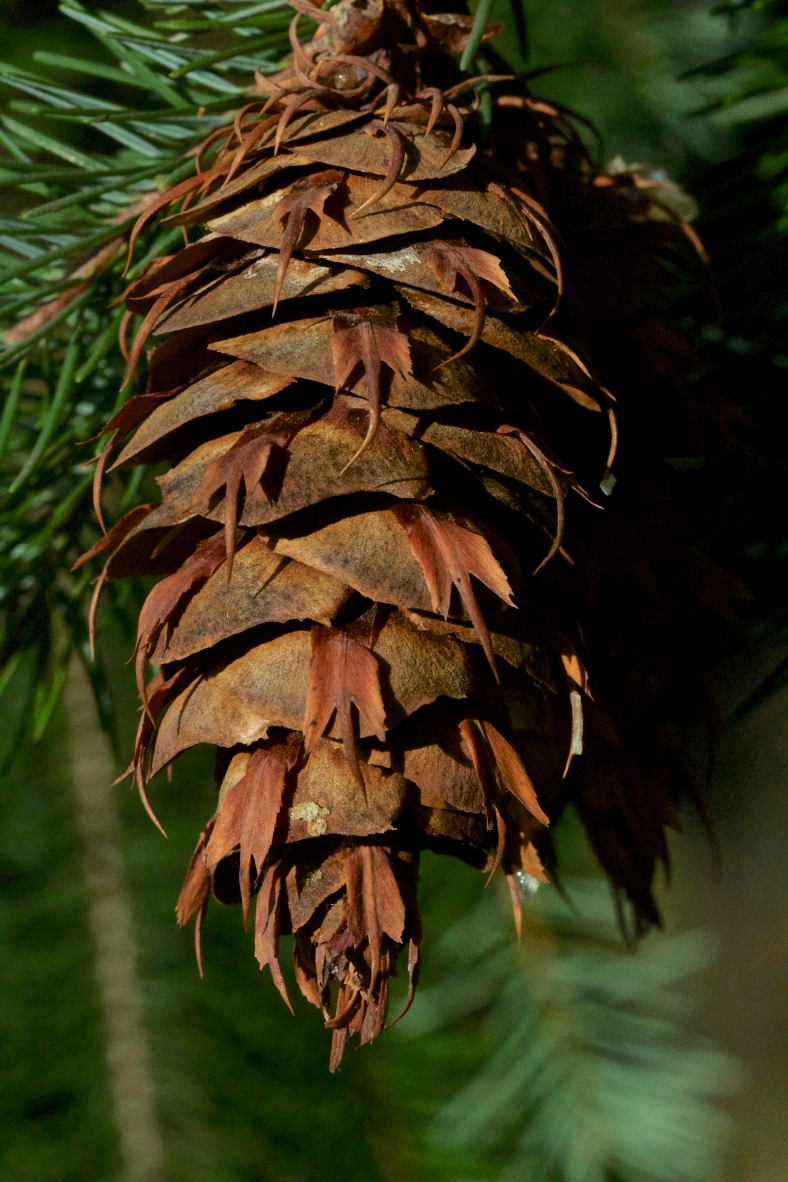
Complex story lines of the earth underlie each species of life. Regional watershed geography shapes and informs the evolutions of ecosystem communities. Phylogeography (the geographic history of species evolutions over time) is revealing that more ancient watershed topographies inform the genetics in a landscapes living communities. Ancient watershed landscapes genomic (DNA) legacies can overlap speciations driven by more modern landscape and subsequent climatic realities. Interestingly it is being discovered that two separate gene sets can often comingle with phenotypes (the varieties of physical expressions responding to different environments) that look the same to the casual observer – and yet under closer genetic analysis multiple species with completely separated strategies can coexist within the shared landscape. Ancients and moderns living together. There may be more diversity within Douglas Fir Communities than we have yet comprehended.

The structure and make up of Cascadian forests has been dynamic forever – it has not ever been static from a geologic timeframe. The most significant modern version of Doug Fir is the Coastal variety Pseudotsuga menziesii. Though Coastal Doug fir can become one of the tallest and most elderly of trees it’s opportunities to do so have been severely diminished since industrial logging has passed through the landscape – reducing protected ancient forest habitats to less than 7 % of the area that had developed since the last major glaciation 12,000 years ago. Interestingly it is not the climax tree in many of our forest systems – and diminishes in density when forests are relatively free from catastrophic disturbance. As recently as 1200 years ago much of the Olympic Peninsula went through a 4000-year period with no Douglas Fir. Douglas Fir cannot propagate in shade – Hemlock, Red Cedar and Spruce can propagate in shade and rise up through Douglas Fir eventually replacing it in the most stable coastal ancient forests. Doug Fir tends to come in after catastrophes such as hurricane blowdowns or fires, opening the way for its more modest climax elders. It is believed that it returned to the Peninsula followed a dry climatic period in which fire reopened sun exposed landscapes. Its adaptations to fire and the dry heat of summer have kept it in the mix making it the dominant coastal tree from southern BC to Northern California. Coastal Doug Fir can grow up to 5500 feet elevation in its southern range but can be limited to as low as 2000 ft on the northern edge of it’s range. In contrast – the Rocky Mt. Doug Fir grows at over 10,000 feet on Mt. Graham in Arizona.

A note on this concept of ancient forest. Historically the forest industry has attempted to marginalize old growth by describing it as past maximal growth or decadent. Don’t believe it in the literature – read it as slowing of the wood used to make lumber. Numerous recent studies have contradicted this industrial bias showing that growth, carbon sequestration, hydrology and ecological services are all increased with the age of trees and systems. Over a 1000 species (that is the ones big enough for humans to notice easily) are ancient forest dependent in the Cascade portion of the region alone. Doug fir stands acquire old growth characteristics at between 150 to 200 yrs while some other regional trees require as long as 360 years to acquire ancient forest characteristics. In the Pacific Coastal states of the region it is estimated in a 2006 Conservation Biology published study using land sat analysis that 72% of historic ancient forests have been destroyed since colonization of the region began (under 7% protected). This may underrepresent the actual loss, as it tends to be the steepest, highest altitude and least productive areas, which have been preserved.
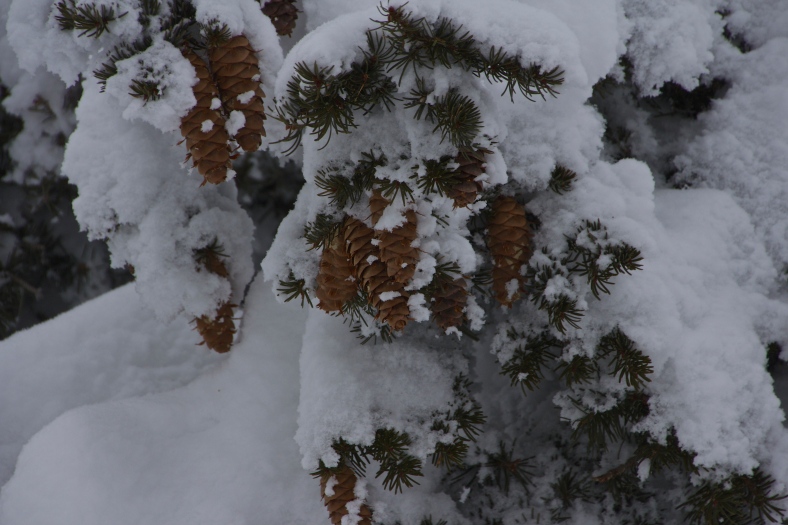
On a recent trip to the Wasatch Range – a western front of the Rocky Mountains, which drain into the Great Basin, an adjacent bioregion to Cascadia, we found ourselves travelling among Doug fir at over 9000 feet. Doug Fir exists in Sky Islands – isolated by discontinuous forest – a refuge of plants and animals from ancient times alive in the high mountains. The same tree as we know in the Cascades expresses a completely different lifestyle adaptation in the Rockies – capable of withstanding much greater cold and altitude. This got me asking a lot of questions: Who is Doug Fir? It’s Origins? What are its speciation’s and relatives? What kind of journeys has it taken as the earth has changed? How does this story inform its future in light of global warming and ongoing climate change?
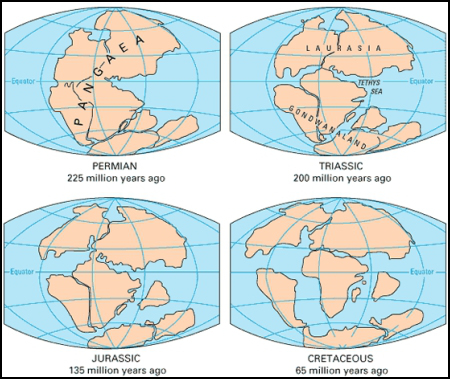
Here is a roughed out story – as well as I have been able to gather – from a few weeks of reviewing research into the fossil, paleontological and genomic records. Pseudotsuga is a member of the Pinacea family, which is one of the most ancient families of trees. The Gingko which is often considered as the most ancient seed producing tree diverges with the Pine family about 225 Ma (million years ago) during the time that all of the continents were unified in the super continent Pangaea. (This is about the time it takes our solar system to make one spin around the milky way galaxy.) It is thought that Pseudotsuga and Larix (the deciduous conifer Larch) differentiated at about 135 Ma, which was when Laurasia (A twin daughter of Pangaea) was just beginning its separations into the present continents of North America, Asia and Europe. This unified origin of landmasses in the Northern Hemisphere explains in part the Holarctic phenomenon of species, which pervade all of the northern latitudes. Grey Wolf, Brown Bear, Red Fox, Moose, Caribou, Elk, Salmon, Golden Eagle, Raven and Wolverine are among the Holarctic species. Communication between Asia and North America during the lowered sea levels of Pleistocene glaciations (the last 2 ½ million years) has facilitated more incidences of homology between Siberia, Alaska and Cascadia than in other cross continental regions. Pinacea is the dominant genera of Holarctic tree. A challenge in finding accurate paleontological evidence for ancient samples is that Larix and Pseudostuga pollen look exactly the same under a microscope – requiring an electron microscope to differentiate the two. Fossil evidence is usually needed to corroborate pollen evidence in the oldest samples. This has not been a problem in Asia and North America but has been more challenging in Europe. The primary bottleneck in recent history for the survival of the species has been the maximum glaciations of the Pleistocene, which were as recent as 18,000 years ago. In North America it is thought that the tree was reduced to 3 refuges in the southern Rocky Mountains and along the coast 3 refuges, which were in the Salish Sea lowlands, Willamette Valley and the California Bay Area. Mexican populations are thought to have origins, which go back to the early Pleistocene (2 Ma) though today these populations are much reduced in Sky Islands, which are not able to communicate genetically. In Europe it is thought that during the Mindel glaciation it was not able to find refuge and became extinct about 450,000 years ago. The common name of the tree refers to the Scottish Botanist who was an early European botanical collector, David Douglas, who reintroduced the tree to Europe where it now grows again in forest plantations.

4 species of the tree exist in the America’s – another 4 are indigenous to Pacific Asia. There is ongoing debate and a lot of variety in naming subspecies and negotiating boundaries between species and subspecies so don’t take this in too fixed of an imagination. Pseudotsuga menziesii is the Coastal Doug Fir and it has a close relative with whom it easily interbreeds var. glauca also known as Rocky Mountain Douglas Fir – It is also sometimes referred to as Blue fir as it is less green and bluer green in color. Coastal fir is found from mid British Columbia down to Yosemite in the Sierras. It is the most economically significant forest product tree on the planet. It is not usually a climax tree in temperate old growth forests – as its seedlings are shade intolerant. That changes in areas where fire occurs more often. That doesn’t mean it isn’t a part of old growth forests however – the oldest known tree is over 1300 years old! Hemlock, Red Cedar and Spruce grow up through Douglas Fir eventually replacing it in coastal forests. There are many variations of forest types it is a part of varying from a seral (successional) to climax species. Disturbed sites keep Douglas Fir active within old growth systems – and human disturbances and forestry practices have increased the proportion of Douglas Fir in forests over the last 200 years. The richest and most developed forest ecologies have developed over 12 to 14,000 years since the last glaciations of the Pleistocene in the transition into the Holocene. It has only reached into it’s most northern zones in the last 9000 years. There has been some Holocene (the last 10,000 years) retraction to the south now being reversed by climate change.
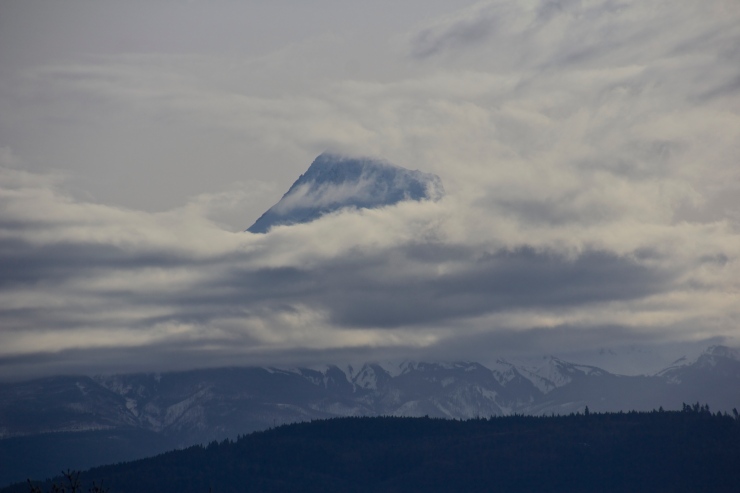
Rocky Mt. Fir grows from Alberta all the way into central Mexico. Pseudotsuga menziesii var. glauca exists in contiguous forest communities where the Rockies receive maritime influenced weather but becomes isolated to sky islands in Utah and farther south into the Southwest and Mexico. The oldest known tree is just under a 1000 yrs which is rare – this tree is an isolate that is in a lava bed where it has not been exposed to fire.
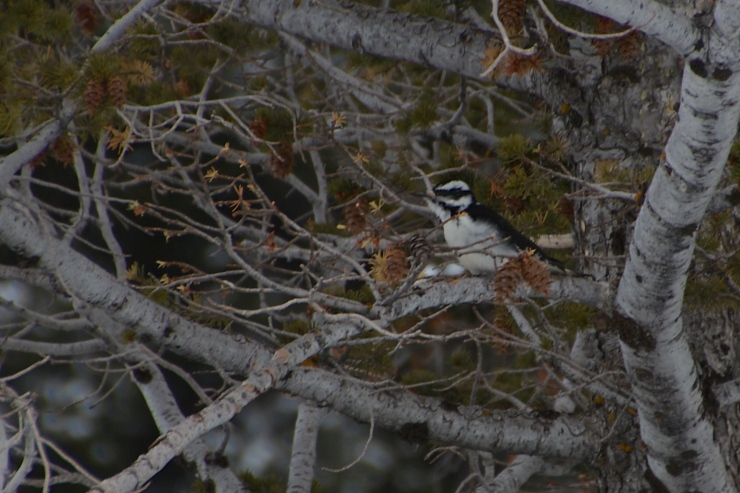
A third species exists in southern Mexico and is found as far south as Oaxaca. Four subgroups are sometimes recognized in Mexico – Pseudotsuga menziesii var. glauca in Mexico: P. macrolepis, P. rehderi, P. guinieri, and P. flahaultii. Mexican Douglas Fir has also been referred to as (P. lindleyana) And even P oaxacan. This diversity of subspecies is under debate and there is a similar set of diversities in naming regarding the Asian species. All of these divergent species tend to be smaller, exist is relatively isolated islands and are less economically significant in comparison to the Coastal Douglas Fir.

“Douglas-fir (Pseudotsuga menziesii) ranks as the second tallest tree species in the world behind coastal redwood (Sequoia sempervirens), and contains the largest trees in the entire Pinacea family. The tallest known Douglas-fir (Pseudotsuga menziesii) is the Brummit Fir (located in Coos County, Oregon), which reaches the height 328 feet. In terms of thickness the Queets Fir, located in Olympic National Park, has a diameter at breast height of 14.3 feet. Most old growth Douglas-fir (Pseudotsuga menziesii) range in height from 200 to 250 feet, and have a diameter of 5 to 8 feet. The oldest known Douglas-fir (Pseudotsuga menziesii) can be found on Vancouver Island in British Columbia, and is estimated to be between 1300 to 1400 years old (Earle 1999).”
from the Biogeography of Douglas-fir (Pseudotsuga menziesii) by Jordin A. Williams
A fourth North American species, Pseudotsuga macrocarpa, is an isolated species endemic to chaparral, live oak landscapes in southern California. . It does not hybridize with menziesii in nature though the University of Oregon has artificially created a hybrid, which is being planted widely because of its hardiness in stressed niches. It is a climax species that is prime habitat for black bears in the spring.
In Asia the forms of the tree are smaller and in relatively isolated small stands occurring in Japan, Taiwan and China. Japanese and Chinese varieties are distinct with multiple intergrades. Most of these asian species are threatened or endangered by agriculture, industrial forestry and isolated populations with few individuals. Here are some maps.
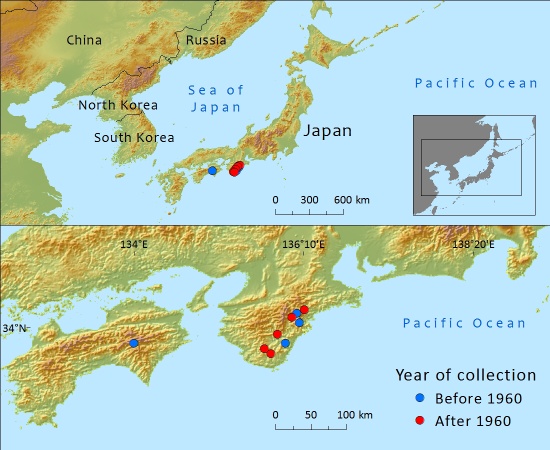
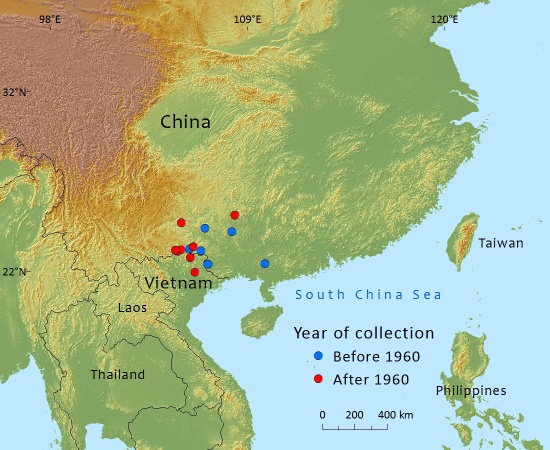
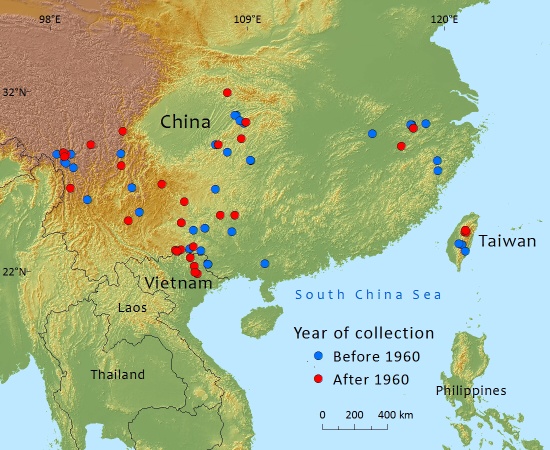
In most of the literature when questions of geographic origin for Doug fir are explored it is assumed that the origins are post Laurasian and are either Asian or Cascadian. There does not seem to be conclusive evidence for a definitive origin of existent species. Gene clocks are evidenced through genomic analysis and as more work is done analyzing differentiations this question may find resolution. One of the oldest fossil sites is a Pseudotsuga macrocarpa found in the Willamette Valley of Oregon, which has led some theorists to believe that the isolated southern California species is the parent of menziesii and that the Asian species evolved through Pacific crossings (live seed has floated from the west coast to Hawaii). Pseudotsuga menziesii does have two extra genes representing an ancient divergence. Originally the coastline of Cascadia would be in what is now Idaho. The continental geography of North American was 15 degrees south of where it is now, which corresponds to the current latitude difference between the centers of menziesii vs. macrocarpa range.
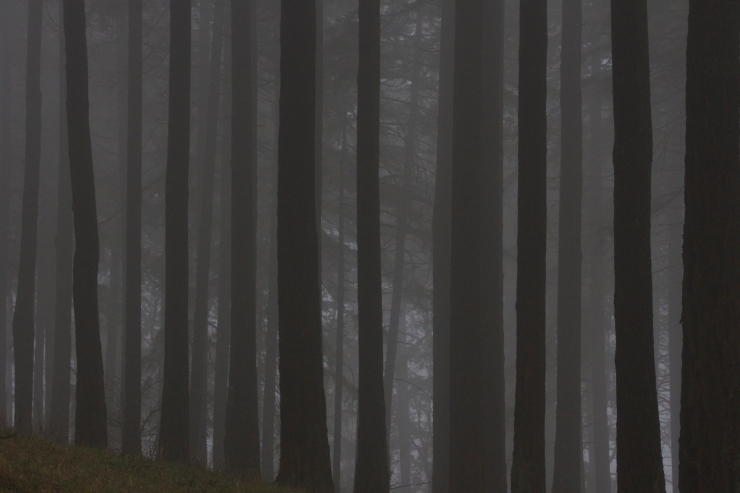
Divergence of Coastal, Rocky Mountain and Mexican Doug fir consistently tracks in genomic studies to the early Pleistocene. At that time climate tended to be milder and more consistent between the coastline and the Rockies and was inhabited more uniformly with forest (and much richer diversities of megafauna). It was during this time that the volcanic Cascade Range began to develop and cast its shadow into the Columbia Plateau. The drying effect of the rain shadow created a disappearance of the connective forest between the two populations. At the same time a cycling of glaciations running southward destroyed existing forest and pushed the species south arriving in Southern Mexico almost 2 Ma ago.
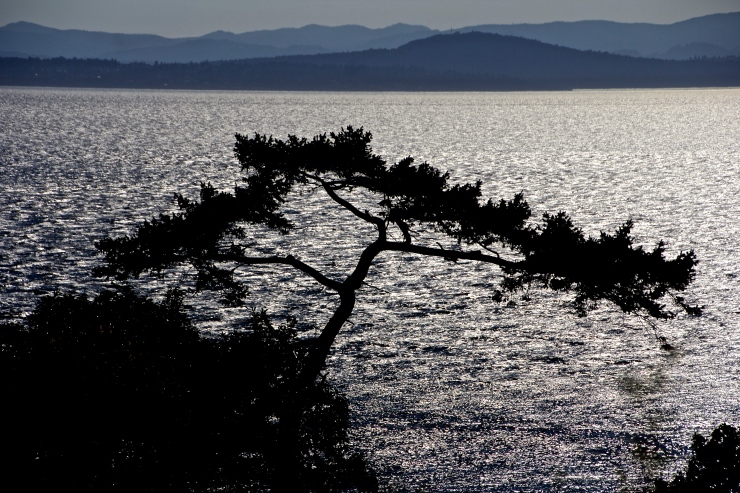
Those areas in the Rockies in which Psuedotsuga is found in the largest contiguous forests are the Columbian forest of Southern BC, Alberta, Northern Idaho and Western Montana, which are heavily influenced by maritime storm tracks. Today this area intergrades with coastal Doug Fir in the North Cascades of Washington State and Southern BC.
Doug Fir is wind pollinated and so can communicate genetically over large areas. Despite free movement of genetic material it does type itself genetically to aspect (solar orientation), elevation and rainfall. In studies on single mountains it has been found that there is a consistency in the genetics found with southern solar exposure as distinct from northern exposures showing that it has developed distinct genetic as well as phenotypic strategies of adaptation to place. It is thought that this sorting is done through sapling survival rates of the diversity of available genetics.
Rates of historic migration of the genetics during glaciations and the subsequent recolonizations have been calculated. These rates of migration are slower than current projected rates of climate change to occur in this century. It is estimated that the Mexican species – which have been in place for almost 2 Ma will be extinct by 2050 to 2080. This is because of the sky island isolation of populations and the distances of discontinuity – together with projected drying of the climate in Mexico. It’s our hope that average rates do not reflect possible rates and that existing conservation efforts will collaborate with the trees survival in its southern range. 135 million plus years of experience is in the genetic record and there may be a trick or two the trees have we have not imagined. That said extinction records are increasing exponentially on the planet in what is the 6th great extinction of life on the planet. It is credibly estimated that we are currently losing 10,000 to 100,000 species a year on the planet in the current year of 2014. Protection of existing habitats in the southern margins and interconnecting corridors for genetic migration are needed.
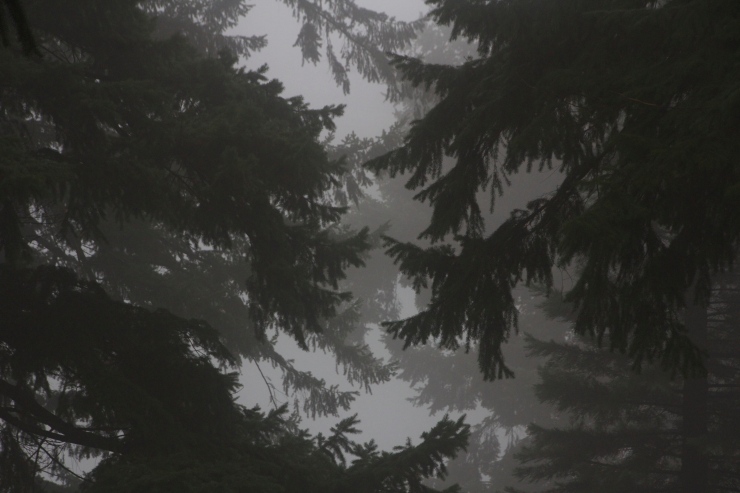
Several seeds of Coastal Douglas Fir were taken around the moon and have subsequently been planted out – in Oregon these are on the State Capital grounds and on the campus of the University of Oregon. Who knows what the moon has put into the mix.
Over a thousand mycorrhizal associate mushrooms – both endo and ecto – have been documented for the tree. It has lots of network associates!
Doug Fir is a deep and wondrous community being that towers into the heavens as it softens the extremes of weather and makes the air we breathe and the homes and food of millions of beings. She connects us, to ancient unities that transcend the separations of time. She has proven herself capable of navigating fire, ice, long dry summers, long wet winters over millions of years. She softens the winds and heat and cold of time and offers us the air we breathe, she has been a part of making the climates in which we can thrive. That we now are endangering her existence in places she has been generously offering herself for millions of years is astonishing. May we awaken to her richness and do our part to extend her generosities. Long live Doug Fir!
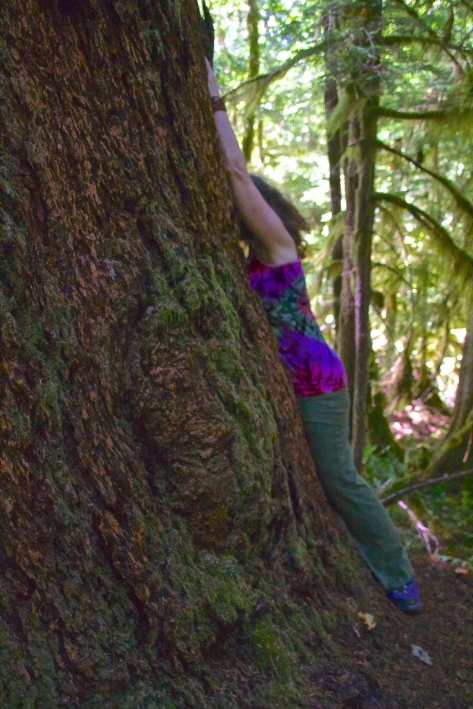
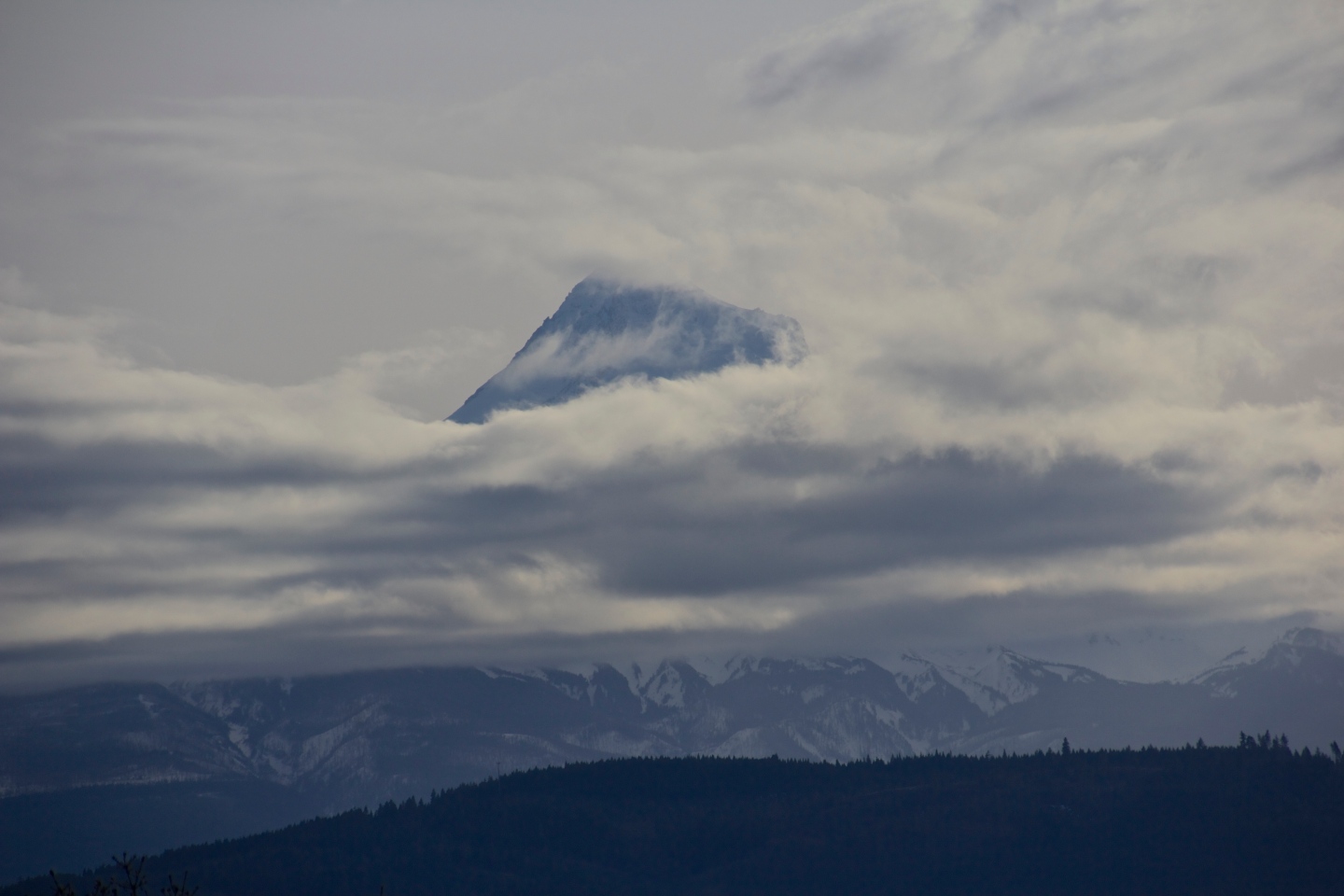
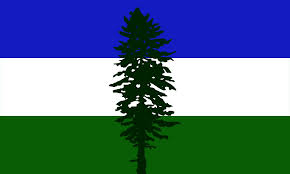
I wonder… are the Douglas firs in the grasslands east of the coast mountains a distinct species, too? Do you know? They certainly react to the climate in amazing ways. Say, did you know, in British Columbia, research has shown that the size of the old trees is a result of fertilization by dead salmon … the trees are, really, vertical salmon! Verrrrrry nice!
I suspect that that there is a huge continuum of genetics and that the grassland edge of doug fir is where a lot of creative hybrids of coastal and rocky mt doug fir are unfolding – i would not be surprised if their are undetected speciations developed we are yet unaware of…. and good point about the intimacy of salmon and ancient forests… there is a whole lot of Canadian inland salmon that have been blocked by the upper columbia dams… which are starting to undergo an international treaty review… this is a good time to support first nations efforts to regain their treaty right access to salmon for the health of all landscapes – and hopefully we will end the barge traffic blocking celilo falls and rebuild the pathway for salmon back up the columbia system into BC and Alberta… we need the grizzly bears down here to carry the salmon nutrients into our forests – they have been starved of this essential nutrition as all our grizzlies are prohibited from feeding on salmon – and historically they are the biggest path from the rivers into the forests for salmon nutrition – the lack of migratory corridors which buffer them from human densities has created a blockade – a part of essential rewilding the ancient forests systems needed from us ecologically conscious humans … if they are to be sustained
I have a favorite getaway on the Oregon coast. I love these pictures. Thank you for “liking” my blog.
Reblogged this on Seven Trees Farm and commented:
This is an amazing portrait of Cascadia’s beloved conifer – the Douglas Fir. Forget tl;dr, just read it.